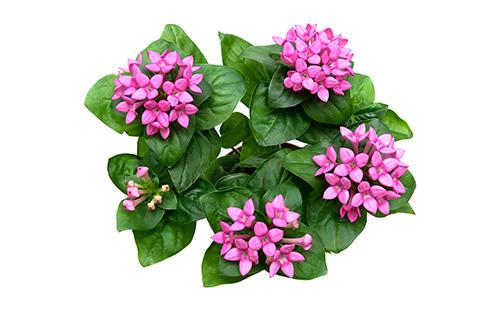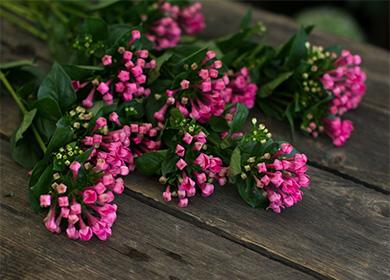The content of the article
The plant belongs to the evergreen, beautifully flowering shrubs of the madder family. The bush is compact, with good care it is densely covered with fragrant flowers. The natural habitat is the subtropics and tropics of Central America, Mexico. In a temperate climate, it is grown mainly as a houseplant.
Description and Features
Bouvardia is a beautiful, compact bush. At home, its height never exceeds 70 cm. The stems are upright, slightly branched. Characteristically large distance between nodes. In indoor crops, branching is enhanced artificially by pruning and pinching.
The shape of the foliage is ovoid or rounded, the tip is sharp. The leaves are dark, plain, located on long petioles. The common color of flowers is orange, white, red. Hybrid species with different intensities and shades of basic colors have been developed.
It blooms for a long time - from the end of summer and almost until the New Year. Inflorescences are numerous, on thick, sturdy peduncles. The size of one inflorescence reaches 15 cm. The flowers are tubular, of four petals, wrapped out. Bouvardia has many popular names. For the shape of the flower, she was nicknamed the little trumpeter. For pollination by hummingbird birds - a hummingbird flower. For abundant flowering and a variety of colors - bush-fireworks.
Indoor Varieties
More than 30 varieties of bouvardia are available for growing in the apartment. Among them there are natural species and artificially bred varieties with improved characteristics. Most often, five species are found among potted crops.
- Smooth-flowered. Compact bush about half a meter high. The leaves are collected in whorls of three pieces. Inflorescences are very dense, corymbose. The flowers are painted in two shades - scarlet on the inside, salmon on the outside.
- Long-flowered. Larger view. With good care, the height of the bush reaches almost a meter. The stems are long, with the opposite arrangement of leaves. Dense pinkish or white inflorescences form in the axils of the leaves, mainly apical. On the windowsills of the apartments is rare - often grown in greenhouses for cutting.
- Home. The general name of varieties developed specifically for cultivation on window sills. Differ in small sizes, plentiful flowering. There are interesting varieties with terry flowers of different colors.
- Yellow. A fairly large variety with dense yellow inflorescences.
- Jasmine. Refers to dwarf species, popular with gardeners. The flowers are numerous, snow-white, similar to bells. Exudes pronounced jasmine aroma.
Proper care for bouvardia at home
Care for the bouvardia in the summer and other times of the year is almost the same - the flower does not have a pronounced period of rest. For abundant flowering of the bouvardia, it is enough to adhere to a number of simple rules.
- Lighting. He loves bright light and the sun. If possible, place on the south window, shading from direct sunlight with a light tulle. In the reviews there is information that the bouvardia calmly reacts to shading. But with a lack of light, the flowering intensity decreases.
- Temperature. The average room temperature is quite comfortable with the bouvard. The range suitable for comfortable growth is 20-25 ° C. Most species in winter need a coolness of about 12 ° C, but during winter flowering, they do not like a resting period, they do not lower the temperature. Cooling should not be allowed below 7 ° C - the bouvardia does not tolerate cold.
- Humidity. Humidity is neutral, spraying is not necessary. Periodically, the bouvard is bathed in the shower - dust accumulates on its smooth leaves, which spoils the appearance.
- Watering. Watering is moderate even in summer, during the period of active growth and flowering. Before watering the bouvardia, make sure that the top layer of the substrate has dried out well. Excess moisture in the soil leads to rotting of the roots. In winter, they are watered very carefully, avoiding stagnation of water.
- The soil. The composition of the soil is not demanding. You can buy any store soil for flowering crops. At home, the soil mixture is prepared from peat, turf, sand, sheet land. Sod prevails in the composition, the remaining components are added a little.
- Top dressing. Fertilizers are applied mainly during the period of active growth - from March to late autumn. The intervals between dressings - about two weeks. In winter, you can feed the bouvardia if it blooms. In other cases, winter feeding is not needed. Standard mineral fertilizers are used.
- Transfer. Bouvard is transplanted at the very beginning of spring. Bouvardia blooms best in the second year, then flowering gradually declines. The plant can be rejuvenated - when transplanting a three-year-old bouvardia, all shoots are cut off, leaving several buds on each. Cut off shoots are used as cuttings for growing young bushes. Instead of transplanting, it is better to use the transshipment method - the bouvard is rearranged in a new pot without destroying the old earth coma.
- Pruning. To maintain decorativeness, you must regularly cut the bouvard. In spring, cut the branches to the desired height, all summer continue to pinch young shoots. This stimulates branching and has a positive effect on flowering.
Breeding methods
Bouvardia is rapidly aging - the lower part of the branches is exposed, flowering is weakening every year. To replace the old bushes grow young plants. Get them by sowing seeds, cuttings or dividing the bush.
Apical cuttings
Propagation of bouvardia by apical cuttings is the most effective, simple and often used method. Cuttings are cut at the end of winter or at the very beginning of spring from healthy, strong branches. A good stalk has two to three internodes, at least 10 cm long.
Bouvardia is easier to root in water with the addition of a small amount of root stimulant. To prevent decay add a tablet of activated carbon. The roots appear pretty quickly. When the root length reaches 1 cm, the cuttings are transplanted into pots with nutrient soil. Two or three cuttings are planted in one pot at once.

Dividing the bush
Dividing the bush among experienced gardeners is considered a simple but undesirable way. When dividing, the bush is not updated - you can not expect abundant flowering from new plants.
Shared by adult, overgrown bushes. Bouvardia is carefully removed from the pot, the roots are freed from soil residues. The roots are cut with a sharp sterile knife. It is enough to divide the bush into two or three parts. The more the bush suffers during division, the longer its restoration will continue.
Sowing seeds
Seeds are sown in early spring in a moistened mixture of peat and sand. Top cover with glass, polyethylene or cling film. They put in a shaded, warm place. Crops are aired daily, regularly moisten the surface of the substrate from the spray gun.
After the first shoots appear, the container is rearranged into the light, but not in a sunny place. Seedlings sprouts in separate containers can be after the formation of several real leaves.
Root offspring
A more successful alternative to dividing the bush is propagation by root cuttings. During the transplant, cut a piece of root with kidneys. Slices dipped in coal powder. Planted in wet sand, kept under a film. After germination, the film is removed.
In the sand, the root is left until stable signs of growth appear. Then the root stalk can be transplanted into ordinary soil. At first, they monitor the condition of a young plant - they do not allow waterlogging, protect from the open sun.

Major diseases and pests
Bouvardia is not often sick - it is quite resistant to fungi. Most common pests of indoor plants also do not show interest in it. For ease of care, all pests, diseases and methods of treatment are collected in one table.
Table - Bouvardia diseases and pests
| Cause | External manifestations | Solution to the problem |
|---|---|---|
| Spider mite | - Light points and cobwebs on the leaves of the bouvard; - sluggish plant | - Increase in humidity; - treatment with Aktara |
| Aphid | - Sticky tops of shoots; - twisted, yellowed leaves | - Trimming of the affected tops; - washing with soapy water, followed by bathing in the shower; - spraying with a permethrin or tobacco dust infusion |
| Root rot | - Yellowed and falling leaves; - constantly wet soil | - Trimming all damaged roots; - treatment of roots with fungicide, coal powder; - transplantation into a new sterile soil; - watering restriction |
| Leaf chlorosis | - Pale leaves with green color only along the veins | - Spraying with preparations with iron chelate |
| Infectious spotting | - Gray or brown spots on adult leaves | - Removal of diseased leaves; - spraying with a solution of Bordeaux fluid |
How to care for the bouvardia so that it will delight you with flowering and its decorative appearance for a long time? She needs very little - good lighting, moderate but regular watering and periodic rejuvenation. Otherwise, this flower requires minimal care.

